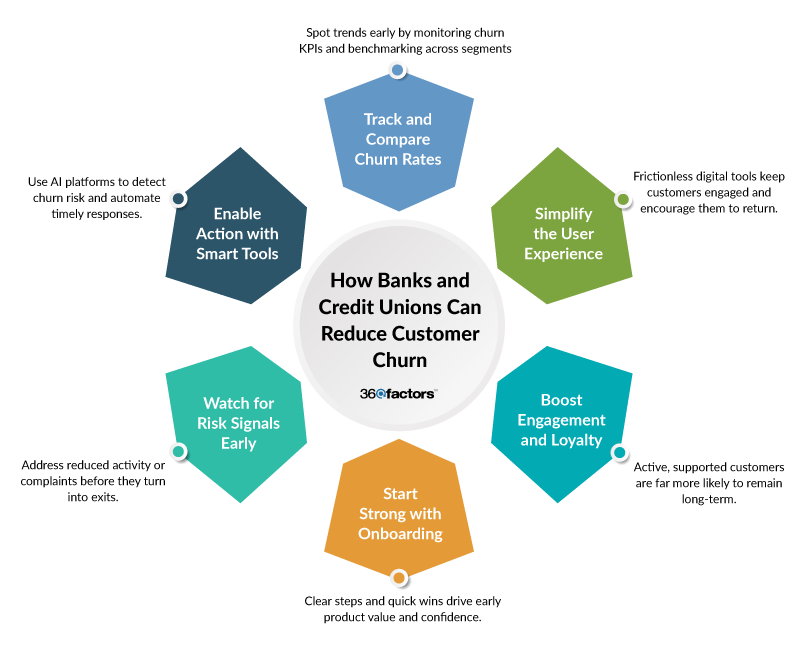Home/ Blog / Maximize Retention Rate with the Power of AI-Based Customer Churn Prediction
Retaining customers has become just as important as acquiring them, especially for banks and credit unions operating in a competitive, fast-evolving environment. While customer churn is a certain part of any business, failing to understand and address its causes can result in significant revenue loss and weakened customer loyalty. Traditional churn tracking methods often lag behind actual customer behaviors, making it harder to intervene before a client leaves. That’s where AI-powered churn predictions come in. By analyzing behavioral patterns, support interactions, product usage trends, and renewal risks, AI tools can help financial institutions proactively identify customers at risk. This allows teams to take targeted, timely action that improves loyalty and protects long-term revenue.
In this blog, we explore what customer churn means, its significance, its causes, and how community banks and credit unions can predict customer churn effectively using modern AI analytics platforms.
What Is Customer Churn and Why Does It Matter
Defining Customer Churn
Customer churn, also known as customer attrition or turnover, refers to the percentage of customers who stop doing business with an organization within a specified period. It is commonly expressed as a churn rate, which compares the number of customers lost (after accounting for new acquisitions) to the total customer base during that time. A high churn rate indicates a significant loss of customers, while a low rate suggests stronger customer retention. Churn is closely tied to customer retention; if one increases, the other typically falls. Understanding both helps businesses assess their overall health and track loyalty trends across their customer base.
The Financial Impact of Rising Customer Churn
The churn has a direct impact on a company’s bottom line. As more customers leave, recurring revenue shrinks, and acquisition costs rise to fill the gaps. For banks and credit unions, this might mean fewer active accounts, lost loan revenue, or reduced product engagement.
Customer churn also reveals operational or service-related weaknesses. When patterns show frequent drop-offs during onboarding or recurring support complaints, it highlights where processes are falling short. Monitoring churn with predictive insights helps organizations pinpoint friction points in their customers’ journeys, whether related to service quality, product complexity, or renewal challenges. Addressing these issues not only reduces churn but also improves the overall customer experience. In today’s financial landscape, where customer expectations are high and loyalty is fragile, identifying churn risk early is essential for long-term growth.
Customer Churn Analysis: Common Reasons for Leaving
To effectively reduce churn, banks and credit unions must first understand why customers decide to leave. These reasons can surface at any stage of the customer journey, from the first interaction with sales to renewal and beyond. Below are the most common causes of churn:
1. Sales Misrepresenting Product Capabilities
When sales teams overstate the features or promise outcomes that the product cannot deliver, customers often feel misled. This disconnect sets the stage for early dissatisfaction and a higher likelihood of churning.
2. Friction in the Initial Purchase Process
If the buying process is complex, unclear, or delayed, customers may lose confidence before they even start. Poor coordination or lack of follow-up during this phase often results in weakened trust.
3. Incomplete or Failed Onboarding
Customers who don’t successfully complete onboarding often struggle to realize value. Missing milestones, delayed account activation, or lack of guidance during setup can cause disengagement from the start.
4. Difficulty Using Advanced Features
Even engaged customers may churn if they cannot use key product features effectively. A steep learning curve, unintuitive design, or lack of training materials can drive frustration.
5. Poor Customer Support or Success Interactions
Slow responses, unresolved issues, or impersonal service lead to dissatisfaction. Over time, repeated negative experiences in customer churn analysis push customers to seek better service elsewhere.
6. Problems with the Renewal Process
Automated renewals that fail, unclear terms, or a lack of reminders can lead to unintentional churn. If renewal requires manual action, any friction in the process can result in contract lapses.
How Banks and Credit Unions Can Reduce Customer Churn
Reducing customer churn requires a proactive approach across multiple touchpoints in the customer journey. For banks and credit unions, the following customer retention strategies are crucial for enhancing retention and fostering stronger relationships.

1. Monitor and Benchmark Customer Churn Metrics
Regularly tracking churn rates and related KPIs enables institutions to spot customer churn signals early. Benchmarking performance over time and across customer segments helps identify where improvements are needed most.
2. Improve Usability and Customer Experience
A user-friendly interface is critical, especially for online banking and digital services. Customers expect intuitive design, fast access, and easy navigation. Improving the usability of digital channels reduces friction and encourages repeat engagement.
3. Promote Engagement and Customer Success
Engaged customers are more likely to stay. Setting clear success milestones and providing resources to help customers achieve them boosts satisfaction. Playbooks and success plans tailored to specific customer segments help maintain long-term relationships.
4. Strengthening Onboarding and Product Adoption
A strong start sets the tone for retention in the customer churn process. Guiding customers through onboarding with clear steps, support, and timely follow-ups ensures they reach their first valuable moment quickly. Tracking feature adoption helps identify users who need additional assistance.
5. Prepare for Escalations and Renewal Risk
Establishing protocols for issue resolution and monitoring account activity for churn signals, such as reduced login frequency or repeated service requests, enables teams to act before customers disengage or decline to renew.
6. Using Software Tools to Support Customer Churn Reduction
Modern platforms provide dashboards, automated alerts, and predictive insights. These tools help teams stay ahead of customer needs, detect risk, and coordinate outreach. For community banks and credit unions, integrated customer churn solutions that combine customer data with automation enable more effective churn management through predictive retention insights.
How AI-Based Customer Churn Prediction Enhances Retention
AI-based customer churn prediction is changing how banks and credit unions approach retention. Instead of waiting for customers to leave, AI identifies early signs of disengagement by analyzing behavioral data, such as usage patterns, support activity, and transaction frequency. These insights enable teams to intervene more effectively and retain a higher percentage of customers. AI also allows dynamic segmentation, which helps update customer profiles in real-time based on changing behaviors. This enables financial institutions to deliver more personalized experiences that cater to each customer’s current needs.
Stay Ahead of Customer Churn with Lumify360 AI Analytics
Staying ahead of customer churn requires more than just tracking numbers; it takes real-time visibility into customer behavior and the ability to act quickly. Lumify360 AI-driven customer insights give banks and credit unions the insights they need to identify and reduce churn before it impacts revenue.
By analyzing transaction patterns, engagement signals, support interactions, and product usage trends, Lumify360’s AI-driven insights uncover early signs of dissatisfaction or disengagement. This allows teams to segment customers dynamically, receive automated alerts when behaviors indicate risk, and personalize outreach based on each customer’s journey. Instead of relying on manual reports or delayed feedback, financial institutions gain continuous, actionable insights that help retain high-value customers.
Additionally, Lumify360 enables financial organizations to forecast behaviors, identify at-risk customers before they leave, optimize upsell and cross-sell opportunities, enhance marketing ROI through advanced segmentation, and uncover hidden trends in customer behavior and transaction patterns. AI analytics provides the clarity and control needed to boost retention and protect revenue across the board.
Request a Demo
Complete the form below and our business team will be in touch to schedule a product demo.
By clicking ‘SUBMIT’ you agree to our Privacy Policy.



